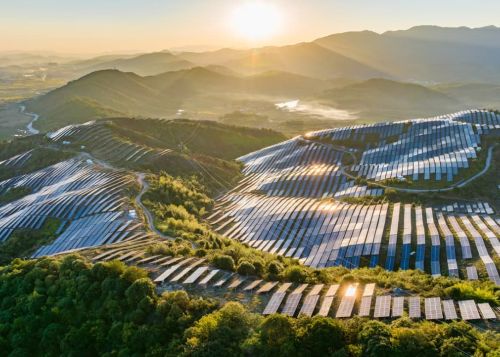

What China is attempting underscores a broader truth about the energy transition. The question is not only how to produce clean power but how to weave it into the rhythms of daily life.

By Matthew A. McIntosh
Public Historian
Brewminate
A Solar City in the Sky
On the Tibetan plateau, where air is thin and the horizon seems endless, China is assembling the world’s largest solar farm. The scale is staggering: 610 square kilometers, nearly the size of Chicago, lined with photovoltaic panels catching the high-altitude sun. At this elevation, solar radiation is intense and the land, often inhospitable to agriculture, can be repurposed for energy without the same displacements faced in denser regions.
The sheer ambition of the project reflects more than engineering confidence. It is a declaration. For years, Beijing has promised to lead the clean energy transition. Now, in a moment when much of the world’s climate commitments appear hesitant or fragmented, China is turning its promises into visible infrastructure.
Surpassing the United States
In the first half of 2025 alone, China added 212 gigawatts of new solar capacity. To put that in perspective, the entire solar fleet of the United States will be smaller than the capacity China installs in a single year. This is not marginal growth. It is exponential.
The numbers have real consequences. China’s carbon emissions fell by about 1 percent during the same period, even as overall electricity demand increased. That decline may sound modest, but in a country that still relies heavily on coal, reversing the emissions trajectory while expanding the grid is no small feat.
What it signals is that clean energy can begin to decouple economic growth from rising emissions. For decades, analysts spoke of that decoupling as theoretical. China, however imperfectly, is demonstrating it in real time.
The Grid Problem
Yet for all the triumphalism, one stubborn problem threatens to slow the pace: transmission. The Tibetan plateau may be ideal for solar capture, but the country’s industrial heartlands lie thousands of kilometers to the east. Steel, cement, and manufacturing plants in provinces like Jiangsu, Zhejiang, and Guangdong are the real engines of energy demand.
Sending electricity from Tibet to those regions will require high-voltage direct current (HVDC) transmission lines of unprecedented capacity. China has been a pioneer in HVDC technology, but scaling it to this magnitude is daunting. Losses accumulate over distance, maintenance is complex, and building out corridors that stretch across multiple provinces is as much a political negotiation as a technical one.
Already, some solar and wind farms in western China operate below capacity because there is no efficient way to send their energy eastward. The phrase “curtailment” has become a bureaucratic euphemism for wasted potential, a reminder that clean energy is not just about creating electrons but about moving them.
Geopolitical and Cultural Dimensions
The decision to place such a vast solar project in Tibet is not only technical. It carries cultural and political weight. The plateau is home to Tibetan communities whose relationship with Beijing has long been fraught. Large-scale infrastructure projects, from railways to hydropower dams, have often been criticized as expressions of central authority more than partnerships with local populations.
In this context, the solar farm is both a climate strategy and a political gesture. It anchors the region more firmly within China’s development vision, reinforcing the narrative that Tibet is a resource frontier for the nation’s future. The symbolism may resonate in Beijing, but it also raises questions about who bears the costs and who reaps the benefits of this “green” expansion.
Climate Leadership or Mirage?
Globally, the project is a message. As the United States struggles with divided politics and the European Union faces regulatory fatigue, China can point to tangible gigawatts as proof of leadership. It strengthens Beijing’s hand in climate diplomacy, allowing it to claim moral authority while reminding the world that decarbonization is also a race of scale.
But there is a danger in the spectacle. Building the largest solar farm may distract from deeper structural issues in China’s energy mix. Coal plants are still being approved, albeit at a slower pace. Air quality in cities remains fragile. And while solar is expanding rapidly, integrating it reliably into a grid that was designed for steady coal output remains a monumental challenge.
If the farm on the plateau becomes a shining symbol but leaves behind persistent bottlenecks, the achievement risks looking like another kind of mirage.
The Larger Lesson
What China is attempting underscores a broader truth about the energy transition. The question is not only how to produce clean power but how to weave it into the rhythms of daily life. Transmission lines, storage technologies, and political agreements are just as important as panels and turbines.
The Tibetan plateau project illustrates both sides of that lesson. It is a breathtaking feat of scale, one that may reshape global solar statistics for decades. At the same time, it reveals the fragility of an energy transition that depends not only on ambition but on the less glamorous labor of connecting supply to demand. For now, the panels are rising. They glitter in the thin mountain air, testifying to a nation’s determination to harness the sun. Whether they become the engine of a new era or the emblem of an incomplete promise will depend on what happens far beyond the plateau: along the wires, substations, and contested corridors that link the highlands to the coasts.
Originally published by Brewminate, 08.27.2025, under the terms of a Creative Commons Attribution-NonCommercial-NoDerivatives 4.0 International license.


